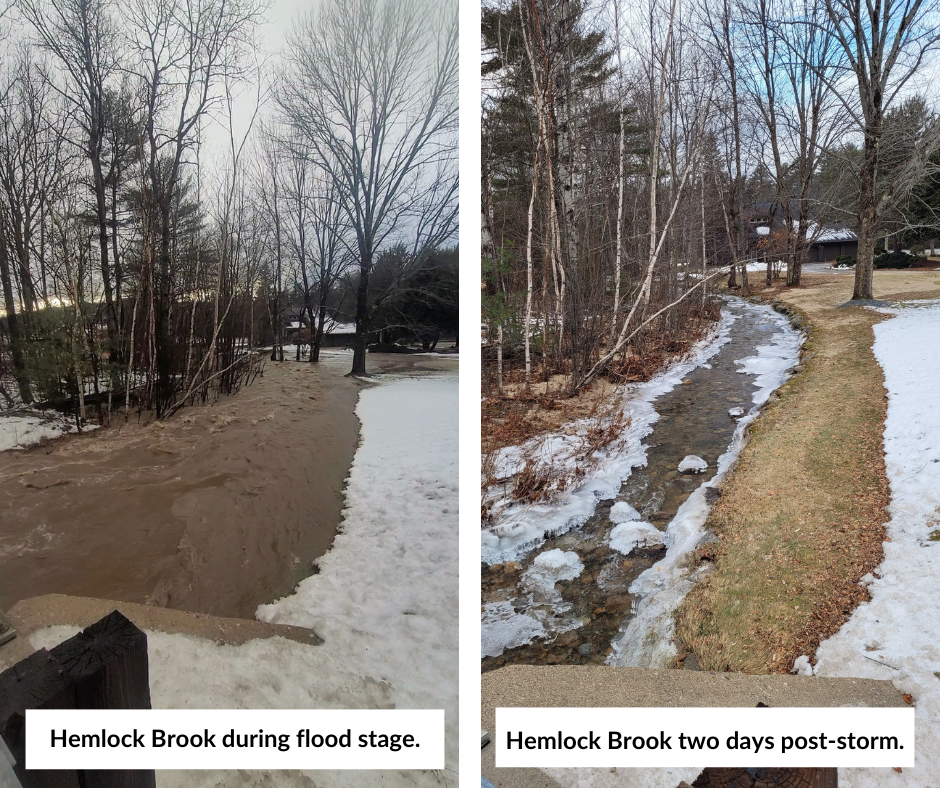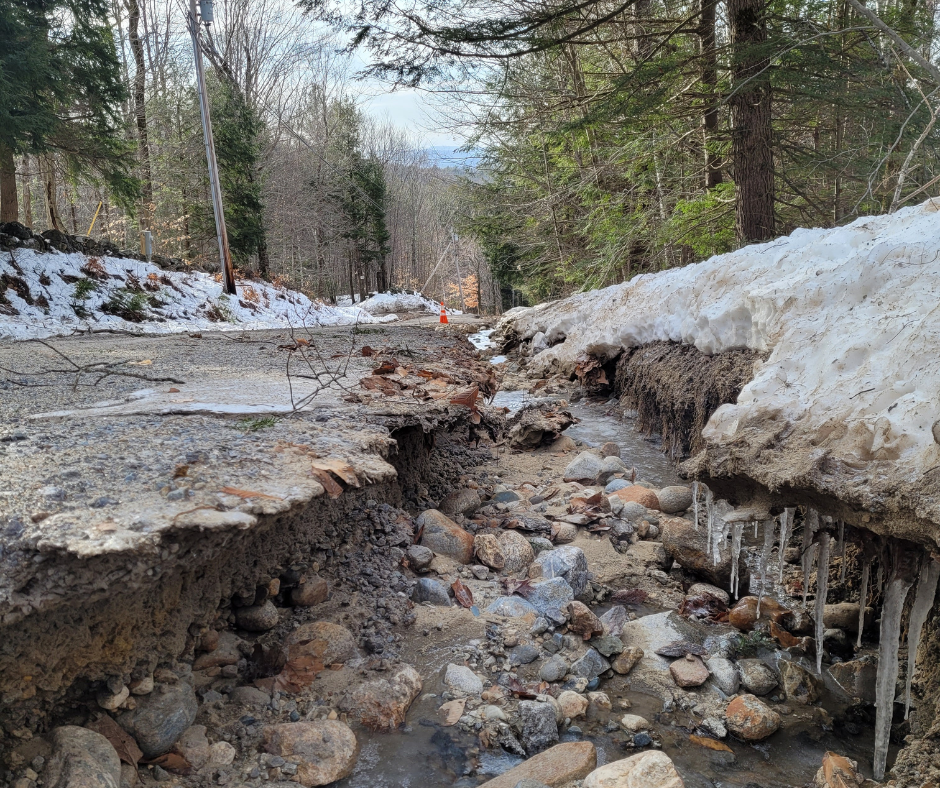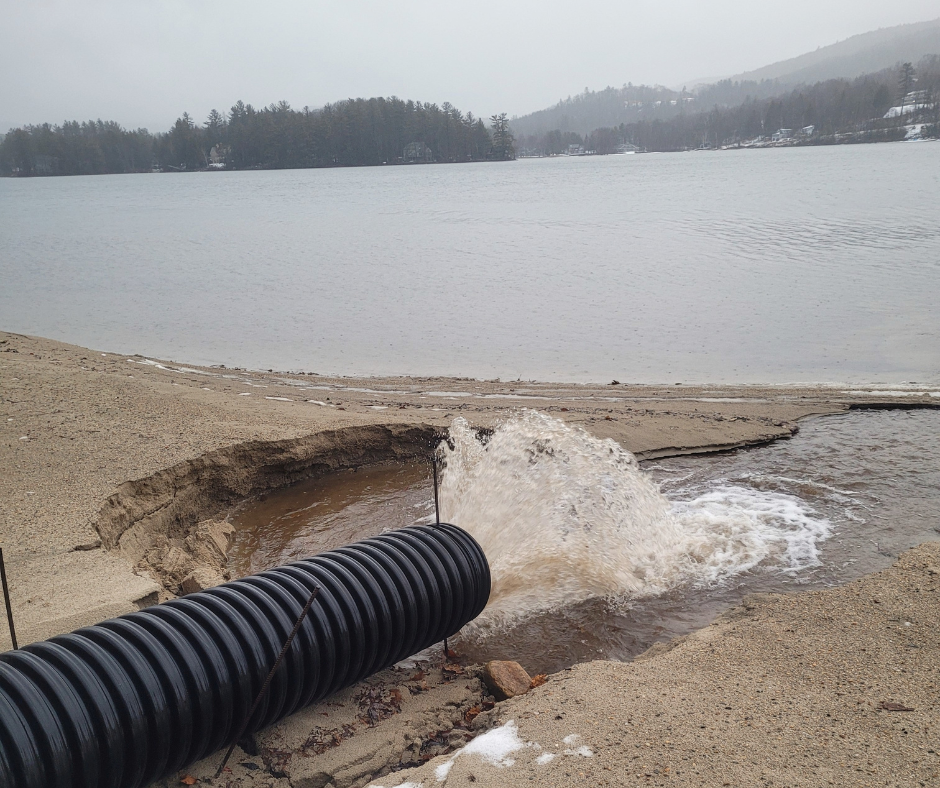by Paul Pellissier, Conservation Program Manager
Between 3:00am and 7:00pm on December 23, 2022 over 2.75 inches of rain fell on the Newfound Watershed. Still blanketed by deep snow from a storm the week prior, the rain and unseasonably warm temperatures that accompanied Elliot sent meltwater rushing over frozen ground. Runoff carrying sediment and pollution quickly caused Newfound’s tributaries to jump their banks, taxing the water management infrastructure we all rely on and threatening Newfound’s water quality.
Despite dam gates being wide open, the storm raised the level of Newfound Lake nearly a foot and a half. Flood waters scoured drainage ditches, overtaxed culverts, washed out gravel roads, and overtook sections of North Shore and West Shore roads. Low-lying homes were flooded, power was lost, evening commutes lengthened —life interrupted by the power of liquid water on a winter landscape.

While we would expect to see flooding associated with a storm of this intensity, Elliot’s flooding was exacerbated by several factors.
- Frozen and saturated soils: Healthy soils act as a natural sponge, absorbing water and slowly releasing it following a rain storm. In winter, soil pores fill with melt water and freeze from the top down, creating a frozen barrier that prevents additional infiltration.
- Lack of active vegetation: Throughout the growing season, plants and other soil organisms take up large amounts of water from the soil. During the dark days of winter, the majority of plant life in the watershed has dropped its foliage and lies dormant, with little demand for roots to draw water from the ground.
- Ice and snow altering drainages: Snow banks piled along roads can prevent heavy rain from draining to ditches, and ice from rivers and streams can block culverts, causing new drainages to form and leading to washouts and flooding.
Large flood-producing storms remind us of connections we all share with water. Our homes, driveways, and roads all shed water and are connected through an intricate network of ditches, swales, and culverts that channel stormwater away from areas where it could do damage. In some cases, the path of stormwater is slowed through built infrastructure such as detention basins and gravel wetlands. More often, stormwater is diverted to areas of natural vegetation where it has a better chance of infiltrating before reaching natural waterbodies. Large rain and melt events stress the entire drainage system. Even small failures, such as a clogged driveway culvert, can quickly cascade, creating large impacts.

Before the rain had stopped, town highway departments, emergency response personnel, homeowners, and neighbors came together to repair roads, restore power, and assess homes and property damaged by the storm. Efforts to get our community back to normal leading up to the Christmas holiday were truly commendable, but the impact of stormwater extends beyond damaging infrastructure. Stormwater carries with it sediment, nutrients, road salt, and other pollutants – representing the single largest threat to Newfound’s water quality and aquatic ecosystem.

Stormwater from large rain-on-snow events will always be difficult to manage. Elliot’s flooding reminds us that we are all connected and can play a part in managing stormwater in every season. Here’s how you can manage stormwater to protect your property and Newfound’s waterways:
Manage stormwater at the source: As stormwater concentrates and flows downhill it quickly gains enough power to erode soils and damage gravel roads. Roofs and driveways concentrate the largest amount of stormwater on an average property. Installing dripline infiltration trenches, deadending gutters in dug drywells, properly grading driveways and maintaining vegetated drainage swales are straightforward and make a big difference.
Use your landscaping to soak up stormwater: Installing terraced gardens across the slope of a hill will help slow stormwater down, causing it to infiltrate, protecting water quality and watering your plants at the same time.
Buffers are a must: If you live near the lake or any of Newfound’s tributaries, maintaining a natural vegetated buffer at the shoreline is a must. Buffers act as the last line of defense to prevent stormwater from polluting waterways. Buffers can come in all shapes and sizes and can be an attractive addition to the landscape. Click here for more information.
Stay tuned this spring as we roll out new programs and stormwater resources for homeowners that include small-scale stormwater assessment, free site-design services, and project assistance for impactful stormwater projects. More information on NLRA stormwater management efforts can be found at NewfoundLake.org/stormwater.

